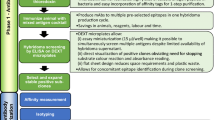Abstract
High-quality antibodies must have high specificities and titers. The development and application of high-quality antibodies have greatly contributed to our current understanding of the life sciences, including neuroscience. However, it is often difficult to develop high-quality antibodies for neural proteins with complex and highly ordered structures and compositions, such as receptors and ion channels. As a researcher who has tackled the production of polyclonal antibodies, this chapter introduces the procedures for antigen peptide preparation, immunization, serum preparation, affinity purification, and specificity tests that I have adopted and modified over three decades. I believe that the two key points in high-quality antibody production are the whole-or-short strategy in which the full length or short peptides are preferable to the incomplete length as immunizing peptides and the gold-dust-fishing strategy by which useful antibodies are purified using affinity peptides designed to be shorter than, or displaced from, immunizing peptides.
Access this chapter
Tax calculation will be finalised at checkout
Purchases are for personal use only
Similar content being viewed by others
References
Watanabe M, Fukaya M, Sakimura K, Manabe T, Mishina M, Inoue Y (1998) Selective scarcity of NMDA receptor channel subunits in the stratum lucidum (mossy fiber-recipient layer) of the hippocampal CA3 subfield. Eur J Neurosci 10:478–487
Fukaya M, Watanabe M (2000) Improved immunohistochemical detection of postsynaptically located PSD-95/SAP90 protein family by protease section pretreatment. A study in the adult mouse brain. J Comp Neurol 426:572–586
Yoshida T, Fukaya M, Uchigashima M, Kamiya H, Kano M, Watanabe M (2006) Localization of diacylglycerol lipase-α around postsynaptic spine suggests close proximity between production site of an endocannabinoid, 2-arachidonoyl-glycerol, and presynaptic cannabinoid CB1 receptor. J Neurosci 26:4740–4751
Miyazaki T, Yamasaki M, Hashimoto K, Yamazaki M, Abe M, Usui H, Kano M, Sakimura K, Watanabe M (2011) Cav2.1 in cerebellar Purkinje cells regulates competitive excitatory synaptic wiring, cell survival, and cerebellar biochemical compartmentalization. J Neurosci 32:1311–1328
Uchigashima M, Yamazaki M, Yamasaki M, Tanimura A, Sakimura K, Kano M, Watanabe M (2011) Molecular and morphological configuration for 2-arachidonoylglycerol-mediated retrograde signaling at mossy cell-granule cell synapses in the dentate gyrus. J Neurosci 31:7700–7714
Yamasaki M, Okada R, Takasaki C, Toki S, Fukaya M, Natsume R, Sakimura K, Mishina M, Shirakawa T, Watanabe M (2014) Opposing role of NMDA receptor GluN2B and GluN2D in somatosensory development and maturation. J Neurosci 34:11534–11548
Konno K, Matsuda K, Nakamoto C, Uchigashima M, Miyazaki T, Yamasaki M, Sakimura K, Yuzaki M, Watanabe M (2014) Enriched expression of GluD1 in higher brain regions and its involvement in parallel fiber-interneuron synapse formation in the cerebellum. J Neurosci 34:7412–7424
Acknowledgments
I appreciate all my colleagues who have used my antibodies in their splendid anatomical experiments.
Author information
Authors and Affiliations
Corresponding author
Editor information
Editors and Affiliations
Rights and permissions
Copyright information
© 2021 The Author(s), under exclusive license to Springer Science+Business Media, LLC, part of Springer Nature
About this protocol
Cite this protocol
Watanabe, M. (2021). Production of High-Quality Antibodies for the Study of Receptors and Ion Channels. In: Lujan, R., Ciruela, F. (eds) Receptor and Ion Channel Detection in the Brain. Neuromethods, vol 169. Humana, New York, NY. https://doi.org/10.1007/978-1-0716-1522-5_1
Download citation
DOI: https://doi.org/10.1007/978-1-0716-1522-5_1
Published:
Publisher Name: Humana, New York, NY
Print ISBN: 978-1-0716-1521-8
Online ISBN: 978-1-0716-1522-5
eBook Packages: Springer Protocols




